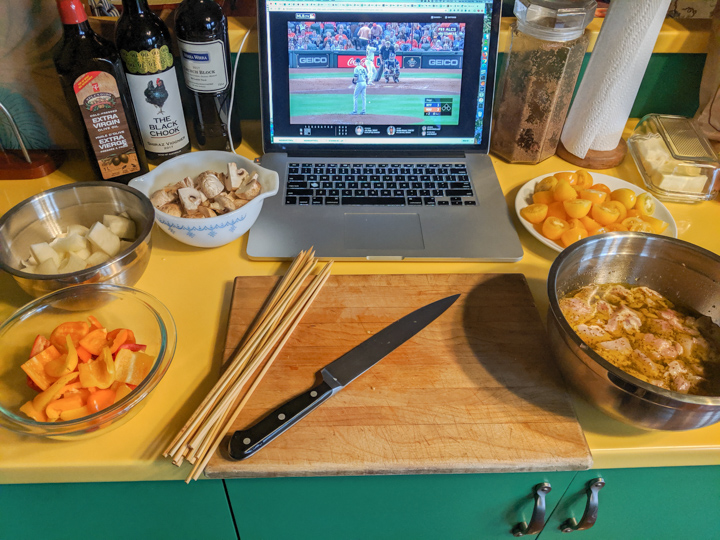
Easy Reliable Chicken Kebabs

This involves a certain amount of chopping stuff up, also attention to hygiene, but requires no particular technical skill and has never ever failed to get rave reviews.
Infrastructure and ingredients ·
A barbecue. Charcoal is said to produce better flavor but gas is immensely faster and easier.
Skewers. Metal or wood, whatever.
Chicken. I’m lazy, I buy it skinless & boneless from the supermarket. Breasts are easier to work with but thighs come out a little better. A kg will satiate four large hungry people.
Lemons. You could use the stuff that comes in bottles but that would be lame. Juicing lemons is easy.
Olive oil. If you think it makes a difference you can pay up for “Extra Virgin”. I do recommend looking for a respectable brand because I gather there is some seriously sketchy stuff upstream of the liquid labeled as “olive oil” on many store shelves.
Garlic. You could be sincere and slice or mash it, or you could buy a jar of garlic paste or minced garlic at the aforementioned supermarket, as I do.
Black pepper. Fresh-ground really does make a difference.
Other things to go on the skewers. The only essential thing is onions (but shallots are better). Also popular: Small tomatoes, mushrooms, sweet peppers (Aussies: I mean capsicum).
The chopping part is kind of boring, so I watched the ALCS.
Safety note: Several of these steps require getting intimate with uncooked chicken. Which can contain the sort of microorganism that causes major unhappiness. So a hot-soap-and-water hand-wash is in order whenever you move from the raw-chicken part to any other part. And then give the part of the counter where you did the raw-chicken stuff a good scrub.
Procedure · First, you make the marinade. Mine is equal-ish parts olive oil and lemon juice, with several large dollops of garlic paste, and lashings of black pepper. If I have oregano (dried not fresh) handy I throw some in; if not I don’t worry about it. Mix vigorously. You need enough marinade to cover your chicken and a little bit goes a surprisingly long way. Say 3 juicy lemonsworth and the same or a little more olive oil.
Cut up your chicken. You want pieces of a size and shape that go comfortably on the skewer. I tend to favor smaller rather than larger to increase the surface-area ratio, because the surface is where the marinade soaks in.
Drop the chicken into the marinade and swish it around. Put it in the fridge and ignore it for a while. I think two or three hours is plenty, but purists do all this the day before. Important: Count the pieces as you cut them up.
Now we’re getting ready to cook. Here’s where you need to get quantitative. Figure out how many skewers you want to make (or maybe just how many you have) and look studiously blank while you sip a glass of preprandial wine and calculate how many pieces of chicken per skewer. Since each chicken chunk should have one or more non-meat items separating it from the next, you now have sufficient information to calculate how many pieces of (for example) onion, mushroom, pepper, and so on you need. The one I did today had three pieces of chicken, two pieces of onion, one piece of pepper, two pieces of mushroom, and two cherry-tomato halves (one red, one yellow) on each skewer. I had forty meat morsels, and I made twelve skewers for the four of us, so the veggie numbers were easy to work out.
Ready for the grill.
Stop here and, if you are using wooden skewers, drop them in a sink-full or pot-full of water to get somewhat fireproof.
Cut up all your vegetables and fungi. I like to grab a bunch of cereal bowls, one for each ingredient. I try to cut them roughly the same size as I did the chicken, so that when I put them on the barbecue you won’t have a big hunk of onion shielding the meat from the flame, or the other way around. If you have a compost bin, move it from wherever it is to where you’re slicing, to capture the waste.
OK, pull the meat out of the fridge. Pour the marinade down the drain. Grab a big plate to put the completed skewers on. Arrange the chicken and all the other skewer-fodder and the plate as seems best to you. I’m a soulless geek so I work out a repeatable skewer script (e.g. tomato, chicken, onion, mushroom, chicken, pepper, mushroom, chicken, onion, tomato) and stick with it.
At some point halfway through, wash your hands and go fire up the barbecue.
Once you’re done you’ll have a satisfying heap of skewers on the plate, and quite a bit of chicken pollution on your hands and the counter. If you miscalculated and there are bits of leftover vegetable or chicken stick the ones you can on skewers and throw the rest out, they’re unsanitary.
Slap ’em on the barbecue, wait till one side is done, turn ’em over, wait again, then enjoy. Tongs help. If you’ve kept the size of the chicken morsels down, then when one side is visibly seared I find it’s reliably cooked inside. Four or five minutes each side works for me, but that’s on my barbecue with my preparation habits. You do really need to make sure the chicken’s done.
Accompaniments · Rice works well. I like to toss asparagus or broccoli on the part of the barbecue that isn’t full of skewers, but whatever. White wine, or (wouldn’t have said this even a couple of years ago) a good artisanal cider.
Leftovers · There won’t be any. The lemon-soaked garlic-loaded flame-kissed skewer payloads are ravishing. And it’s hard to get this one wrong.
[Disclosure: The attentive observer will notice that the pictures are of a different batch than the one the text describes.]